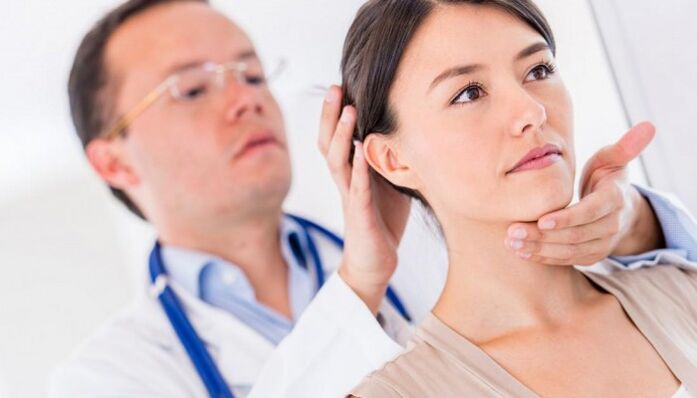Various back or side neck pains can occur suddenly and always cause considerable discomfort. Special vigilance must be caused by the constant painful feelings of an intense nature. It can be accompanied by other clinical symptoms such as neck pain and pain in the upper back, heaviness in the back of the head, fatigue, tiredness, headache, limited mobility.
If the pain syndrome lasts for more than a week and the treatment does not give the desired result, professional medical help should be sought. Do not deprive yourself of the opportunity to quickly and effectively get rid of a painful illness.
Reasons

Many people wonder why the neck hurts? Practical experience shows that there can be many reasons for this. Clarification of such issues should be resolved only by a specialist, because the correctness of treatment depends on it. The most common causes of very bad and frequent injuries to the back and sides of the neck are:
- Cervical spine pathology (various injuries, bruises, displacements, intervertebral hernias, osteochondrosis, spondyloarthritis, etc. ).
- Cervical myogelosis.
- Great physical activity.
- Being restless for a long time (for example, sleeping in a sitting position).
- Cervical sciatica.
- Muscle stretching (sudden movement of the head, improper exercise).
Banal scoliosis has been shown to cause such pain.
Cervical spine pathology
If the patient complains of very strong and frequent pain in the neck and upper back, it is necessary to exclude cervical spine pathology in the first place.
Special attention should be paid to osteochondrosis and spondylosis. Today, these are the two most common diseases of the spine, except for injuries and injuries that can cause significant pain and discomfort in the upper part of the neck and shoulder. Features of pain syndrome in degenerative-dystrophic pathology of the cervical spine:
- The pain is noted at rest, although the patient tries not to move at all.
- In general, it is very difficult for them to choose a position where they will not feel an obvious pain.
- Limitation of mobility in the cervical spine is almost always noted.
- Slight pressure on the cervical spine can cause increased pain.
Cervical lumbar myogelosis

A pathological condition in which there is a painful contraction of muscle fibers associated with local circulatory disorders is called myogelosis. As a rule, the motivating factors are:
- Hypothermia and frostbite.
- Captured draft.
- Anxious situation for a long time.
- Physical fatigue (excessive stress).
Most experts believe that myogelosis should be considered a complication after an inflammatory process in the muscles. It should be noted that this is caused not only by pain, but also by muscle relaxation, increased tone and limited mobility problems. In addition, the pain often extends to the upper back and shoulder girdle. You run the risk of aggravating your health by leaving myogelosis untreated, as the disease tends to progress and become chronic.
If you do not know the real cause of your neck pain, it is better to consult a specialist immediately.
Cervical sciatica

Compression of nerve roots from the level of the cervical spine to the spinal cord causes sciatica. According to clinical practice, in most cases, osteochondrosis leads to the development of this pathology. Patients with sciatica report pain and burning in the neck, which is simply impossible to touch from behind or from the side. What is the clinical picture of damage to the cervical nerve roots from the spinal cord:
- Severe and constant pain in the neck, scapula, shoulder girdle.
- Painful sensations are usually intensified by movements of the head, arms and upper body.
- The neck muscles are extremely tense.
- There is a violation of sensitivity in the hands (numbness, tingling, etc. ).
- Weakness in the upper extremities.
- Dizziness.
- Headache.
- Increased fatigue.
Crick

Despite the severity of the pain syndrome, muscle tension is considered one of the most mild pathologies compared to other diseases that cause neck and upper back pain and is treated very quickly. Injuries, poor athletic performance, and increased stress can cause muscles to stretch. What complaints will patients express at the same time:
- Acute pain in the neck, back of the head and upper shoulder girdle.
- Excessive muscle tension that limits the mobility of the head and cervical spine.
- The general condition suffers (physical discomfort, weakness, fatigue appear).
- The neck hurts when you turn your head.
Diagnostics

It is very difficult to completely eliminate this pathological symptom without studying the specific cause of the appearance of pain in the cervical region. If we only eliminate the painful feelings, if we eliminate the causes, we can only hope for a temporary improvement. Modern diagnostic methods allow you to quickly narrow the possible causes of pain in the back, side or both sides of your neck. As a rule, the following instrumental studies are used:
- Standard X-ray examination.
- Ultrasound.
- Electrocardiography.
- Electromyography.
- Magnetic resonance imaging.
Treatment
What to do if your neck hurts? Even at home, there are some corrective steps you can take to help reduce pain. If you associate the pain with an injury or muscle tension, a cold compress is recommended for the first 48 hours.
A very effective tool is to apply ice or cold objects to the neck area in a few hours for about 15 minutes. Direct contact with the skin should be avoided to prevent the development of cold sores from ice contact. To do this, ice or very chilled items are placed in a plastic bag, additionally wrapped in a non-tight cloth and only then applied to the skin surface.
After two days, switch to hot compresses. You can use an ordinary plastic hot water bottle or a rubber heating pad. The duration of application of the compress should not exceed 20-30 minutes. This procedure can be repeated every 2 hours. In addition, give your sore muscles enough rest. Go to bed more often, trying to relax your neck muscles for the first time after an injury or nose. Eliminates tension best when lying on your backIn the acute phase, it may be helpful to limit yourself to a variety of physical activities. Take a short break from exercising.
Remember that a very long rest helps to weaken the neck muscles and shoulder girdle. Once you return to a normal rhythm, it will be easy to gain a new piece of already weakened muscles. An alternative to dosed physical activity and good rest is considered optimal, but only in the absence of severe pain. Traditional pain treatment is as follows:
- Drug treatment.
- Local treatment.
- Physiotherapy procedures.
- Manual therapy.
- Massage
- Physiotherapy.
Talk to your doctor about what to do if your neck hurts.
Drug treatment

Painkillers help to quickly relieve neck pain of varying intensity. Today, many of these drugs can be bought in pharmacies without a doctor's prescription. However, we must not forget that most of these drugs have many side effects and contraindications. Therefore, any medication should be coordinated with a specialist. Often, non-steroidal anti-inflammatory drugs are used as painkillers.
Numerous clinical studies have shown that taking NSAIDs can cause a number of adverse reactions. Most of the problems are associated with erosive and ulcerative lesions of the gastrointestinal tract. In addition, quite often there is an obvious tension in the neck muscles, along with pain syndrome. It is recommended to use muscle relaxants to relieve muscle spasms.
Local therapy

Topical therapy has been shown to be useful in controlling pain in the neck and upper back. As a rule, all kinds of ointments, gels and creams with a clear analgesic effect are used. Some types of drugs are very popular as foreign substances.
The mechanism of analgesic effect is different and depends on the active ingredient that is part of the ointment, gel or cream. Only a qualified doctor can tell you which medication is best for your condition. Significant discomfort with severe pain, sometimes prescribed novocaine blockade. Medical compresses have also been shown to be effective. The average duration of the procedure is about 30 minutes. In general, you need to perform at least 7-8 procedures to achieve the desired result.
If you are not sure what to do when your neck and back hurt, then it is better to consult a specialist first.
Physiotherapy

In most cases, physiotherapy treatment, consisting of various procedures, massage sessions and physiotherapy exercises, is actively involved. Many years of experience have shown the effectiveness of the following physiotherapy methods to relieve pain:
- Electrophoresis.
- Ultrasound treatment.
- Electrotherapy.
- Magnet.
- Laser.
- Acupuncture.
Sports therapy and massage
Therapeutic exercises and massage are mandatory parts of complex therapy for almost any disease or pathological condition. But many people forget that it can be used only after the acute phase. Contraindicated in severe pain syndrome, exercise therapy and massage. Example of basic physical exercises to relax and strengthen the cervical muscles:
- You can stand or sit. The key is to keep your back straight. Hands should be comfortable and low. Perform 10 head bends to one side and then to the other. Practice at a calm pace without moving suddenly.
- The situation is similar. We try to touch the front surface of the chest with our jaws by tilting our heads down. The number of repetitions is 10 times.
- The situation is similar. We imitate a duck and move its head back and forth. The number of repetitions is 10 times in each direction.
- Slow circular motion of the head. If there are painful feelings, we stop training.
- We sit in a chair. Put your palm on your forehead. We lean our heads forward as we try to resist with our palms. Exercise helps strengthen the front neck muscles. You can place your palm left, right and back and tilt your head to the appropriate side.
- Stand up straight. Relax your arms and place them across your body. When we lift our shoulders, we first bend our head to one side and then to the other. The number of repetitions is 10-12 times.
After a brief briefing from a physiotherapist or other specialist, therapeutic exercises and self-massage of the neck area can be done regularly and without problems at home.
ethnology

It is difficult to argue that traditional medicine has long been entrenched in our lives. However, if you are not sure about the cause of a particular folk remedy, it is not recommended to use it in treatment. Many physicians have seen serious consequences of more than one misuse of non-traditional therapies in clinical practice. In some cases, it is allowed to use certain folk remedies to get rid of pain, but only after consulting a doctor. Here are some recipes from traditional medicine just for acquaintance:
- You can apply a normal fresh cabbage leaf to the painful area. There is no time limit. Compresses made from cabbage leaves also have a good effect.
- Rub the honey. The massaging honey is rubbed on the neck of the patient who feels the greatest pain.
- Mustard-salt compress. You need a kilogram of salt, a tablespoon of mustard powder and 100 ml of water to eat. Pour all ingredients into the pan and heat for 5 minutes. The mixture is then poured into a tissue bag that we put on the painful neck area. You can wrap a warm cloth around your neck (for example, a scarf) to increase the effect.
Prophylaxis

In many cases, the formation of a fairly unpleasant pain in the neck can be prevented. To do this, you need to avoid various injuries, muscle tension and heavy physical exertion. Freezing or over-cooling is highly undesirable. It is also recommended to do active sports, but do not harm your health. Do not start chronic diseases, especially degenerative-dystrophic pathologies of the musculoskeletal system. Get a thorough medical examination at least once a year.
































